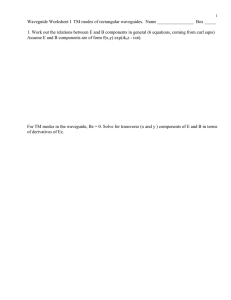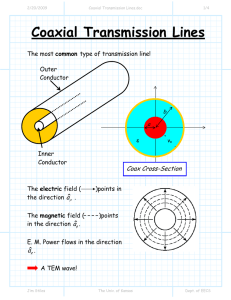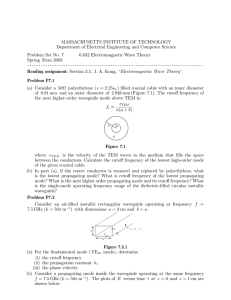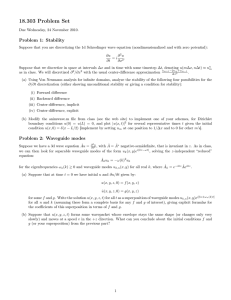Notes on Coaxial Transmission Lines
advertisement
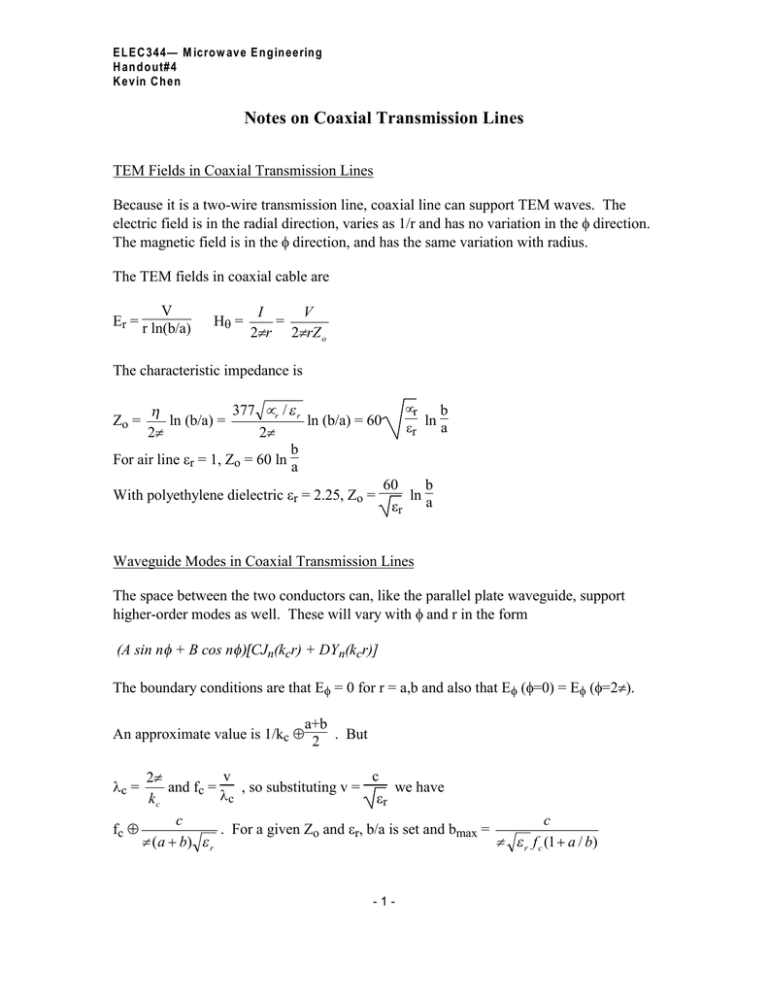
ELEC344— Microwave Engineering Handout#4 Kevin Chen Notes on Coaxial Transmission Lines TEM Fields in Coaxial Transmission Lines Because it is a two-wire transmission line, coaxial line can support TEM waves. The electric field is in the radial direction, varies as 1/r and has no variation in the φ direction. The magnetic field is in the φ direction, and has the same variation with radius. The TEM fields in coaxial cable are V Er = r ln(b/a) Hθ = I V = 2πr 2πrZ o The characteristic impedance is µr b ln a εr 377 µ r / ε r η ln (b/a) = ln (b/a) = 60 2π 2π b For air line εr = 1, Zo = 60 ln a Zo = With polyethylene dielectric εr = 2.25, Zo = 60 b ln a εr Waveguide Modes in Coaxial Transmission Lines The space between the two conductors can, like the parallel plate waveguide, support higher-order modes as well. These will vary with φ and r in the form (A sin nφ + B cos nφ)[CJn(kcr) + DYn(kcr)] The boundary conditions are that Eφ = 0 for r = a,b and also that Eφ (φ=0) = Eφ (φ=2π). a+b An approximate value is 1/kc ≈ 2 . But v c 2π and fc = , so substituting v = we have λc εr kc c c fc ≈ . For a given Zo and εr, b/a is set and bmax = π ( a + b) ε r π ε r f c (1 + a / b) λc = -1- Thus, since the ratio of a/b is determined by impedance and loss considerations, the waveguide mode cutoff frequency is essentially determined by the size (radius) of the coaxial transmission line. The coaxial transmission line is useful only below the cutoff frequency of the first waveguide mode, and a limit of 95% of the cutoff frequency is often chosen. For 50Ω line with εr=2.1, b/a = 3.35 and b < 4.8 cm = 1.90 in. for fc=109 and b < 0.5 cm = .19 in. for fc=1010. The higher the frequency range, the smaller the value of bmax for a given Zo (set by b/a). For a given Zo and b/a, the power handling capability is proportional to b2, so the power handling capacity of coaxial cables decreases as fc2. Power Handling in Coaxial Lines Questions of interest are the maximum power handling capability and the loss as determined by the geometry of a transmission line, giving consideration to any limitations due to presence of higher-order modes. We can make the assumption that waveguide and coaxial cable will be made of copper and will be air-filled in order to derive a comparison that will be instructive. Ignoring thermal effects, the maximum power handling capacity of an air-filled transmission line is set by the dielectric breakdown voltage of air, Ed < 3 x 106 V/m. Heat dissipation due to attenuation losses can also be a limiting factor. For coaxial geometry, the electric field is V E(r) = r ln(b/a) , where a≤ r≤ b. This is maximum at r=a, and must not exceed Ed. The maximum peak voltage Vp is Vp = aEd ln(b/a) The maximum power that can be transmitted is Vp2 πa 2 Ea2 ln x πb2 Ed2 ln(b / a ) Pmax = 2Z = ln(b/a) = which is of the form 2 2 x o η η (b / a ) This has a maximum at x = 1.65 For air line, Zo = 60 ln (1.65) = 30Ω, while for polyethylene dielectric Zo = 20Ω. This shows that power capability increases with larger cables as expected. If consideration is given to high SWR, the electric field can be as much as twice the matched value, and hence the actual power handling limit is one-fourth the value above. -2- For air-insulated line, the equation for Pmax has a broad maximum around b/a = 2.09, which corresponds to Zo = 44Ω. A relationship between power handling capacity and maximum frequency can be generated by combining the equations for Pmax and fc to yield the simple relationship for coaxial cable Ed 2 Pmax = 5.3 x 1012( f ) for coaxial cable (330 KW for fc = 12 GHz, b = 0.2 in.). c By comparison, a similar formula yields Ed 2 Pmax = 26 x 1012( f ) for waveguide (1.6 MW for fc = 12 GHz). c Losses in Coaxial Lines Losses due to surface conductivity are given by the equation Rs Rs (b/a) +1 1 1 1 αc = 2 η ln (b/a) ( a + b) = 2ηb ( ln (b/a) ) , which for constant Zo varies as 1/b. Recalling that skin depth varies as 1/ f and λo = c/f, we see that the attenuation of coaxial cable increases with decreasing b and with increasing f. This would indicate that we would want the largest possible b, but we are again limited by fc of higher order modes. If we again include the effect of fc, we can obtain the relationship δs α = 0.67λ fc o δs = = 0.044fc f , since c .066 for copper. f Keeping in mind the relationship between Nepers and dB, this yields -20 log e-α = 0.18 dB/m at 10 GHz for the best possible coaxial cable. By comparison, copper waveguide has an attenuation of 0.11 dB/m at 10 GHz. Coaxial Line Impedance for Minimum Attenuation and Maximum Power Capacity The expression for conductive loss αc in a coaxial line, assuming equal resistivity of inner and outer conductors, is of the form -3- (1+x) αc = kα ln x , where x=b/a, the ratio of outer to inner radius. If we plot this expression, normalized against its minimum value, as a function of b/a, we see there is a broad minimum around x=3.59. For air line εr = 1, Zo = 60 ln (3.59) = 77Ω; 60 for minimum αc with polyethylene dielectric εr = 2.25, Zo = ln(3.59) = 40 ln (3.59) εr = 51Ω. lnx The expression for breakdown voltage is of the form Vmax = kv x , but since Pmax=Vmax2/Zo, we need to consider instead the maximum power capacity, of the form 3.50 3.00 2.50 2.00 Atten 1.50 Power 1.00 0.50 4 3.8 3.6 3.4 3.2 3 2.8 2.6 2.4 2.2 2 1.8 1.6 1.4 1.2 0.00 b/a lnx Pmax=kp 2 . x If we plot this expression, normalized against its maximum value, as a function of b/a, we can see there is a maximum at x = 1.65. For air line, Zo = 60 ln (1.65) = 30 Ω, while for polyethylene dielectric Zo = 20 Ω.. -4- 90 80 70 60 50 e=2.3 40 e=1 30 20 10 4 3.8 3.6 3.4 3.2 3 2.8 2.6 2.4 2.2 2 1.8 1.6 1.4 1.2 0 b/a These curves appear in Moreno1, and interestingly, are calculated incorrectly in Rizzi2. Since the cross section area affects the inductance per length, and the surface area affects the capacitance per length, it is reasonable that this approximation would yield results comparable to those obtained by more rigorous electromagnetic analysis. Stripline and Microstrip Impedance Estimate In the case where it is filled with uniform dielectric, the stripline configuration supports TEM waves just like any other two-wire structure. The characteristic impedance can be determined by noting that Zo = L LC 1 = = C C vC where L and C are the inductance and capacitance per unit length, and v is the velocity of propagation v= c µrεr Thus we can measure or estimate the value of capacitance per unit length of the structure, and thereby derive an accurate estimate of Zo. Like other TEM structures, stripline also 1 2 Moreno, T., Microwave Transmission Design Data, Dover, 1958, pg. 64 Rizzi, P., Microwave Engineering Passive Circuits, Prentice Hall, 1988, pg. 189-190 -5- exhibits troublesome waveguide modes the restrict its use to frequencies below the waveguide mode cutoff frequencies. As an aside, it is often confusing to think about modes that may be present, but are not energized because of the characteristics of the excitation that provide suitable boundary conditions to only one mode. This is analogous to the example of the military bugle, which can play several notes (modes) depending on how the excitation is applied by the player. Also, many waveguide modes are analogous to the modes of vibration of a rectangular drumhead, which can be excited by striking the drum simultaneously in locations that are maxima of the particular node desired. -6-
